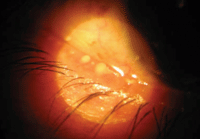 Since March 2011, when the Tear Film & Ocular Surface Society announced that it had released its conclusions and recommendations from the International Workshop on Meibomian Gland Dysfunction, MGD has been on optometrists’ lips perhaps as much as on their patients’ lids.
Since March 2011, when the Tear Film & Ocular Surface Society announced that it had released its conclusions and recommendations from the International Workshop on Meibomian Gland Dysfunction, MGD has been on optometrists’ lips perhaps as much as on their patients’ lids.
While MGD may be the current darling of the optometric media and of CE lectures on ocular surface disorders, the coding front still lags behind.
That’s one of the pitfalls of being on the “bleeding edge” of clinical care—the ICD-9 and CPT machinery haven’t quite caught up yet.
We’re already used to hearing terms like anterior blepharitis, posterior blepharitis and MGD on a daily basis in clinical discourse with our patients and peers, yet none of those terms actually exist in ICD-9 terminology. This means that the very first mistake that most clinicians make is in the diagnostic labeling of MGD. Because MGD doesn’t have its own ICD-9 code, a number of other ICD-9 codes are being used instead, with 373.12 (Internal Hordeolum) as the most common; however, it’s not the most appropriate!
The most appropriate code to use is 373.00 (Unspecified Blepharitis).
Why not 373.0 (Blepharitis)? Because 373.00 (Unspecified Blepharitis) is more appropriate, as it codes to the fifth digit of specificity, which most carriers usually require.
Both of these issues are common mistakes, but ones that are easily rectified in practice.
Treatment Code
On the procedural side, there is really nothing to code other than the office visit itself, using either the 920X2 or the 992XX codes. There is no specific code that describes probing or evacuation of the meibomian glands. I have seen some doctors try to use an inappropriate surgical code to get a higher reimbursement, but then they have to give the money back after an audit.

Photo: Gregg E. Russell, O.D.
Plain and simple: For MGD, there is nothing to code but an office visit encounter.
The only exception to this is if you own a LipiFlow Thermal Pulsation System (TearScience), which is an automated device that uses heat and pressure to evacuate the meibomian glands. This technology is described by the level III HCPCS code—0207T—which is specifically assigned to this procedure. As with most level III codes, this one requires that you submit the code to the medical carrier, but the patient is always financially responsible for the balance.
Also, bear in mind that 0207T is a unilateral code, so be sure to either bill it twice or use the modifier -50 on the code to denote the bilateral application of it, change your units to two, and double your fee when filling out the claim form.
MGD is a fast-growing segment of optometric practice, so diagnosing and treating it can be a rewarding way to provide cutting-edge care to your patients and build your practice. But don’t let the temptations of poorly kept medical records and “enhanced” claim submissions cause you to say “OMG!” for a different reason.
Please send your coding questions and comments to CodingAbstract@gmail.com.

